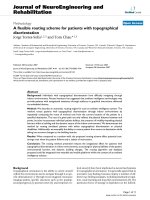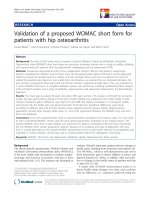Transanal total mesorectal excision for patients with middle and low rectal cancer who have undergone preoperative radiotherapy or chemoradiotherapy: Safe and efficacious
Bạn đang xem bản rút gọn của tài liệu. Xem và tải ngay bản đầy đủ của tài liệu tại đây (572.44 KB, 5 trang )
Hue Central Hospital
TRANSANAL TOTAL MESORECTAL EXCISION FOR
PATIENTS WITH MIDDLE AND LOW RECTAL CANCER WHO
HAVE UNDERGONE PREOPERATIVE RADIOTHERAPY OR
CHEMORADIOTHERAPY: SAFE AND EFFICACIOUS?
Ho Huu Thien1, Pham Xuan Dong1, Pham Nhu Hiep1
ABSTRACT
Introduction: It was found that patients with moderate and low rectal cancers after
chemoradiotherapy had many difficulties in performing laparoscopic total mesorectal excision (TME),
especially in those with narrow pelvis. We conducted the study of transanal TME for patients with
middle to low rectal cancer receiving chemoradiotherapy before surgery to evaluate the safety and
safety of this technique.
Material and method: Patients with middle or low rectal cancer who have received radiotherapy
or chemoradiotherapy before surgery. The diagnosis was based on MRI, abdominal CT scan, rectal
endoscopic ultrasonography and clinical examination. All underwent operation following Ta TME technique
at Hue central Hospital in Vietnam. Hospital ethics committee approval was obtained for this cohort study.
Results: 10 patients underwent elective surgery for middle-low rectal cancer by TaTME from March
2015 to March 2018, there were. Male/female ratio was 7/3. Mean age was 54.8 ± 15.9 and BMI was 21.4
± 1.1 kg/m2.
There were 7 middle and 3 low rectal tumors. Clinical TNM stage:T2N1: 2 patients, T3N0: 4 patients,T3N1:
2 patients and T4N1: 2 patients.
Mean operation duration was 190 ± 38 minutes (150-260). Two patients were exteriorized specimen
through abdominal incision in right lower quadrant and 8 via anus. Anastomoses were performed by
mechanic procedure in 1 and by hands in 9 patients.
and totally necrosis of the anastomose. Good Quick’ assessment in 10/10 patients. The distance from lower
pole of tumor to distal resection margins (DRM) was 19 ± 5 mm. Distal resection margins (DRM) were
negative in 10/10 patients and circumferential resection margins (CRM) were positive in 1/10 patients.The
hospital stay was 6 days (5-8).
Median follow-up time was 14 months. One patient had local recurrence and invaded to urinary bladder
and left ureter at 18 months and was managed by transversal colostomy and left ureterostomy.
Conclusion: Transanal total mesorectal excision for patients with middle and low rectal cancer who
Key words: transanal total mesorectal, rectal cencer.
1. Hue Central Hospital in Vietnam
- Received: 8/8/2018; Revised: 16/8/2018
- Accepted: 27/8/2018
- Corresponding author: Ho Huu Thien
- Email: , Tel: 0905130430
Journal of Clinical Medicine - No. 51/2018
51
Transanal totalBệnh
mesorectal
viện Trung
excision for...
ương Huế
I. INTRODUCTION
Total mesorectal excision (TME) is the goldstandard approach to mid-low rectal cancers with
65% rates of 5 years survival and 6–10% rates of
local recurrence [1,2]. Laparoscopic TME was
proven to be safe with short and long-term results
comparable to open TME [3,4].
However, in patients with middle or low rectal
cancer receiving preoperative chemoradiotherapy,
laparoscopic TME is still considered a challenge.
Several studies reported that macroscopic quality
of TME specimen assessed completely was only
72.4% [5], the rate of APR was 11.2 % [5] and the
rate of conversion to open procedure was 28% [6].
The National Comprehensive Cancer Network
recommends that resectable cT3N0 or any cTN1–2
lesions should be initially treated with preoperative
chemoradiation [7]. With the increasing use of
NCCN guidelines, the number of patients with
middle-low rectal cancer treated with neoadjuvant
therapy is increasing, requiring a new strategy to
minimize the shortcomings of laparoscopic TME.
Transanal TME (TaTME) “open” was reported by
Bannon et al in 1995 [8] and in 2010, Sylla P. reported
the first case of Transanal TME “laparoscopy” [9].
Since then, transanal TME has become increasingly
accepted.
It was found that patients with moderate and
low rectal cancers after chemoradiotherapy had
many difficulties in performing laparoscopic TME,
especially in those with narrow pelvis. We conducted
the study of transanal TME for patients with middle
to low rectal cancer receiving chemoradiotherapy
before surgery to evaluate the safety and efficacity
of this technique.
II. MATERIAL AND METHOD
2.1 Patient’ selection
Selected patients with rectal cancer who gave
informed consent for rectal resection via transanal
total mesorectal excision technique were included.
52
All underwent operation at Hue central Hospital in
Vietnam. Hospital ethics committee approval was
obtained for this cohort study.
Patient selection criteria included: Patients with
middle or low rectal cancer (lower: 3-6 cm from
anal verge, middle: more than 6 to 9 cm), who have
received radiotherapy or chemoradiotherapy before
surgery. Patients with tumor T3, having a clear
margin of circumferential resection margin (CRM)
on MRI, received short-course radiation therapy,
surgery after one week. Patients with tumor ≥ T3 or
positive nodules, long-course chemoradiotherapy,
surgery after 6-8 weeks. The diagnosis was based
on MRI, abdominal CT scan, rectal endoscopic
ultrasonography and clinical examination. Patients
with no distant metastasis, ASA ≤3, have no history
of colonic surgery as well as prostatic surgery.
Exclusion criteria included a synchronous distant
metastasis, another malignancy, severe cardiac
or pulmonary disease, pregnancy, severe medical
disease, and intestinal obstruction or perforation.
2.2. Technique
Place 10 mm trocar in the umbilicus to observe
the peritoneum. In the absence of peritoneal and
hepatic metastases we started firstly TME by
transanal approach.
After placing the lone star® retractor (Cooper
surgical, Trumbull, Connecticut, USA) and then
a Covidien hemorrhoidectomy anal dilator was
placed, the rectum was sterilized with 10% Betadine solution. A purse-string suture closing rectal
lumen was performed one centimeter below the
inferior border of tumor with prolene® (Ethicon,
Cornelia, Georgia, USA) 2.0. This thread was also
used to pull out. Full thickness of the rectal wall
was resected another 1 cm from the suture, starting
at 6 o’clock, then go around the rectum. Attention
was paid when dissection from 11 to 01 o’clock position in men because of urethral injury risk. With
open technique it was easy to perform the mesorectal excision beyond the upper margin of the tumor.
Journal of Clinical Medicine - No. 51/2018
Hue Central Hospital
In these cases, we went a few centimeters away until the ability to observe by “open” surgery was limited, we stopped and moved to the abdomen stage.
In cases where the tumor has not passed through
but the ability to observe by “open” surgery is
limited, we place the SILS port multiple access port
(Covidien Minneapolis) and proceeded the TME
until the peritoneal fold.
The specimens were taken out through the anus
or taken through a skin incision in the lower right
quadrant under a wound protector bag where the
protective ileostomy was planned to be placed and
the anastomoses were made by hand or by mechanic.
Intestinal continuity was re-established after 4-6
weeks or after completion of postoperative adjuvant
therapy.
2.3. Postoperative assessment and analysis
Patient’ demography including age, BMI,
tumor position, preoperative clinical TNM, type of
neoadjuvant therapy was noted.
Rate of conversion, duration of operation,
intraoperative
events
and
post-operative
complications, anastomotic procedure, procedure
of specimen extraction, Quick’ assessment,
circumferential resection margin (CRM) assessment,
distal resection margin (DRM) assessment, pTNM,
hospital stay were recorded.
Follow-up included clinical examination,
carcino-embryonic
antigen
measurement,
colonoscopy and abdominal CT scan.
Patient data are shown as meaṇ (s.d) unless
indicated otherwise.
III. RESULTS
Between March 2015 and March 2018, there were
10 patients underwent elective surgery for middlelow rectal cancer by transanal total mesorectal
excision. Male/female ratio was 7/3. Mean age was
54.8 ± 15.9 and BMI was 21.4 ± 1.1 kg/m2.
There were 7 middle and 3 low rectal tumors.
Clinical TNM stage were detailed in Table 1:
clinical stage
Clinical TNM stage T2N1 T3N0 T3N1 T4N1
n
2
4
Short course
Long course
2
2
Mean operation duration was 190 ± 38 minutes
(150-260), in which mean anal stage duration was
60 ± 12 minutes (40- 75).
Two patients were exteriorized specimen
through abdominal incision in right lower quadrant
and 8 via anus.
Anastomoses were performed by mechanic
procedure in 1 and by hands in 9 patients.
All patients had protective ileostomy in right
lower quadrant.
There was one patient having 1/3 superior left
ureter intraoperative burn which was managed with
JJ catheter placement. This patient then suffered the
difficulty in voiding but resolved after 1 month with
conservative treatment.
Postoperative complications included 1
presacral abscess which was managed by transanal
drainage and the anastomotic open was sutured
after 2 weeks. The other was totally necrosis of the
anastomose. The patient was operated by abdominal
approach descending the colon in order to redo the
anastomose.
The hospital stay was 6 days (5-8).
Anatomo-pathology assessment showed good
Quick’ assessment in 10/10 patients. The distance
from lower pole of tumor to distal resection
margins (DRM) was 19 ± 5 mm. Distal resection
margins (DRM) were negative in 10/10 patients
and circumferential resection margins (CRM) were
positive in 1/10 patients.
Median follow-up time was 14 months. One
patient had local recurrence and invaded to urinary
bladder and left ureter at 18 months and was managed
by transversal colostomy and left ureterostomy. Just
to now the patient was alive.
Journal of Clinical Medicine - No. 51/2018
53
Transanal totalBệnh
mesorectal
viện Trung
excision for...
ương Huế
IV. DISCUSSION
With the results of 10 successful cases of
TaTME surgery without the need for open surgery
or abdominal-perineal resection surgery, we found
that TaTME technique was efficacious for middlelow rectal cancer in patients receiving preoperative
radiation or chemo-radiotherapy.
Some studies have shown the high conversion
rate in patients with mid-low rectal cancer received
preoperative radiation therapy [6,10,11,12]. This
study, although with a small number of patients,
showed the effect of this method with the conversion
rate of 0%. In the other hand, operative duration in
this study was 190 ± 38 minutes, but it ranges from
267-284 minutes in other studies [6,10,11,12]
As we know performing TME in patients with
middle-low rectal cancer was always difficult,
especially in male patients often having narrow
pelvis or obese patients. The difficulty become more
severe in patients receiving chemoradiotherapy
due to unclear dissection plan. Besides, after
radiotherapy, the rectal wall near the tumor became
harder making it difficult to identify the lower
border of the tumor and TME by laparoscopy was
almost impossible in some cases. In these cases, if
the attempt to do so would break the tumor or lead
to APR. We did not have difficulty in performing
TME from the anus. Several authors reported that
the dissection plan was relatively clear by transanal
approach [13,14,15].
In term of technique, in the first eight cases we
pulled the specimen through the anus. In cases of
large tumor, we met the difficult in exteriorization
the specimen and we suspected it was the cause of
one of the complications in our study. So, in the
last two cases, the tumors were quite large. We
removed the tumor through an incision the right
lower quadrant where the protective ileostomy
was planned. This did not increase the incision in
the abdomen because all patients were performed
protective ileostomy.
Ureteral burning patients quite unrelated to TME
technique. Difficulty in voiding in low anterior
resection was also met with a rate and was mostly
restored with conservative treatment.
Presacral abscesses also occur in the TME
technique at a rate of 5% and are usually well
resolved by transanal approach.
Distal part necrosis of the colon that came down
for the anastomose in this study was serious. We
suspected vascular lesions in the process of pulling
the specimen out through the anus. As such, in
the last two cases, a large tumor evaluation may
be difficult to pull out through the anus, we have
removed the tumor through the incision in right
lower quadrant.
In term of oncologic safety, this study showed
100% good in Quick’assessment. Mean distal
margin in this study was 19 ± 5 mm, but other three
studies, the distal margin ranges from 24-26 mm.
This shows TaTME in preoperative patients always
having enough distal margin.
DRM was negative in 100% cases and there was
one positive in CRM. Comparison with TaTME in
patients without preoperative chemo-radiotherapy,
these results were similar (table 2). Performing
TME by transanal, we could correctly determine the
lower margin of the tumor, the resection line, better
view the dissection plan that led the better of TME
quality.
Table 2: Positive rate of DRM and CRM
Study (year)
n
DRM (+)
CRM (+)
Denost (2014)
50
2%
4%
Marks (2013)
106
1%
3.8%
Tuech (2015)
56
NR
5.4%
Kanso (2015)
51
8%
10%
Muratore (2016)
43
0%
2.4%
54
Journal of Clinical Medicine - No. 51/2018
Hue Central Hospital
V. CONCLUSION
Transanal total mesorectal excision
for patients with middle and low rectal
cancer who have undergone preoperative
radiotherapy or chemo-radiotherapy is safe
and efficacious. However, a study with larger
number of patients are needed to evaluate
accurately.
REFFERENCES
1. Heald RJ, Husband EM, Ryall RD (1982). The
mesorectum in rectal cancer surgery-the clue to
pelvic recurrence? Br J Surg 69:613–616
2. Peeters KCMJ, Marijnen COAM, Nagtegaal ID
et al. The TME trial after a medianfollow up of
6 years: increased local control but no survival
benefit in irradiated patients with resectable rectal
carcinoma. Ann. Surg. 246, 693–701 (2007)
3. Kang SB, Park JW, Jeong ST et al. Open versus
laparoscopic surgery for mid or low rectal cancer
after neoadjuvant chemoradiotherapy (COREAN
trial): short-term outcomes of an open-labelrandomized controlled trial. Lancet. Oncol. 11, 637–
645 (2010).
4. Van der Pas MHGM, Haglind E, Cuesta MA et
al. Laparoscopic versus open surgery for rectal
cancer (COLOR II): short-term outcomes of a
randomized, Phase 3 trial. Lancet Oncol. 3, 2101–
218 (2013).
5. Rullier E, Denost Q, Vendrely V, Rullier A, Laurent C. Low rectal cancer: classification and standardization of surgery. Dis. Colon Rectum 56,
560–567 (2013).
6. Denoya P, Wang H, Sands D, Nogueras J, Weiss
E, Wexner Steven D. Short-term outcomes of
laparoscopic total mesorectal excision following
neoadjuvant chemoradiotherapy. Surg Endosc
(2010) 24:933-938.
7. Engstrom PF, Arnoletti JP, Benson AB, et al.
NCCN Clinical Practice Guidelines in Oncology:
rectal cancer. J Natl Compr Canc Netw 2009;7:
838–81.
8. Bannon JP, Marks GJ, Mohiuddin M, Rakinic J,
Jian NZ, Nagle D. Radical and local excisional
methods of sphincter-sparing surgery after high
dose radiation for cancer of the distal 3 cm of the
rectum. Ann. Surg. Oncol. 2(3), 221–227 (1995).
9.Sylla P, Rattner DW, Delgado S, Lacy AM.
NOTES transanal rectal cancer resection using
transanal endoscopic microsurgery and laparo-
scopic assistance. Surg. Endosc. 24, 1205–1210
(2010).
10. Liang JT, Lai HS, Lee PH (2007) Laparoscopic
pelvic autonomic nerve-preserving surgery for
patients with lower rectal cancer after chemoradiation therapy. Ann Surg Oncol 14:1285-1287.
11.Akiyoshi T, Kuroyanagi H, Oya M, Konishi T,
Fukuda M, Fujimoto Y et al (2009) Safety of laparoscopic total mesorectal excision for low rectal
cancer with preoperative chemoradiation therapy.
J Gastrointest Surg 13:521-525.
12.Sung-Bum Kang, Ji Won Park, Seung-Yong
Jeong, Byung Ho Nam, Hyo Seong Choi et al.
Open versus laparoscopic surgery for mid or low
rectal cancer after neoadjuvant chemoradiotherapy (COREAN trial): short-term outcomes of an
open-label randomized controlled trial. Lancet
Oncol 2010; 11: 637–45.
13.Denost Q, Adam JP, Rullier A, Buscail E, Laurent
C, Rullier E. Perineal transanal approach: a new
standard for laparoscopic sphincter-saving resection in low rectal cancer, a randomized trial. Ann
Surg. 2014 Dec;260(6):993-9.
14.Tuech JJ, Karoui M, Lelong B et al. A step toward NOTES total mesorectal excision for rectal
cancer: endoscopic transanal proctectomy. Ann.
Surg. 261, 228–233(2015).
15.Marks JH, Myers EA, Zeger EL, Denittis AS,
Gummadi M, Marks GJ. Long-term outcomes by a
transanal approach to total mesorectal excision for
rectal cancer. Surg Endosc. 2017;31:5248–5257.
16.Kanso F, Maggiori L, Debove C, Chau A, Ferron M, Panis Y. Perineal or abdominal approach
first during intersfhincteric resection for low rectal cancer: which is the best strategy? Dis. Colon
Rectum 58, 637–644(2015).
17.Muratore A, Mellano A, Marsanic P, De Simone
M. Transanal total mesorectal excision for cancer
located in the lower rectum: short- and mid-term
results. Eur. J. Surg. Oncol. 41, 478–483 (2015).
Journal of Clinical Medicine - No. 51/2018
55









